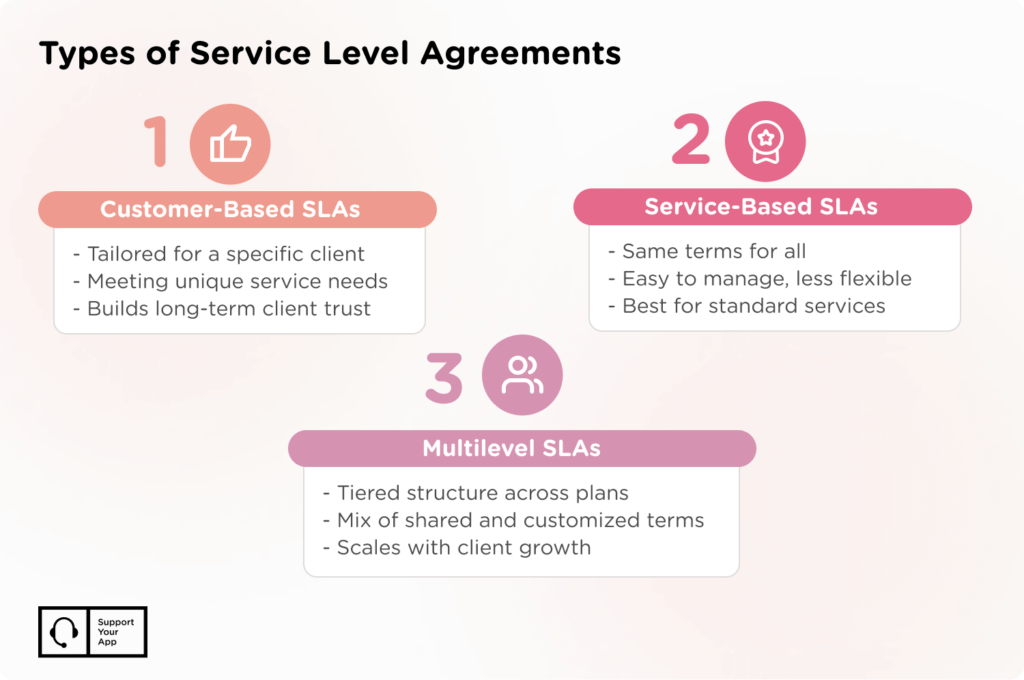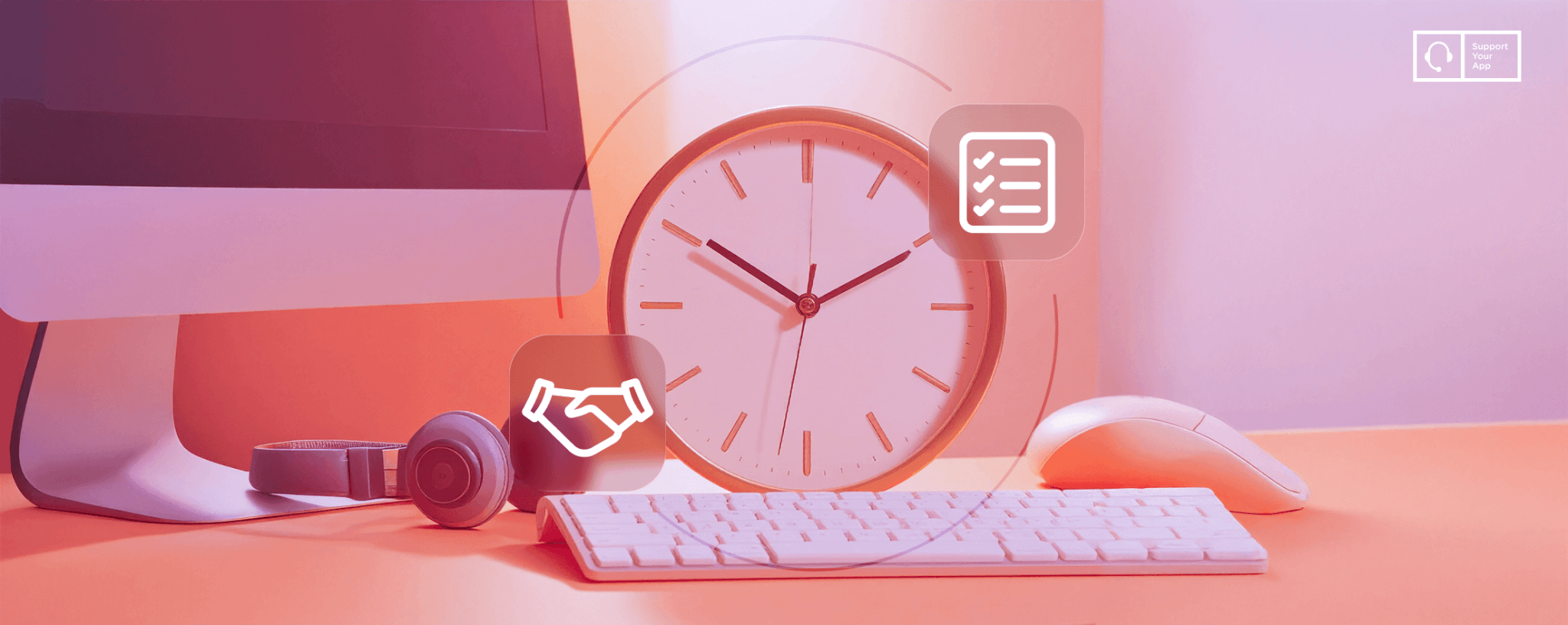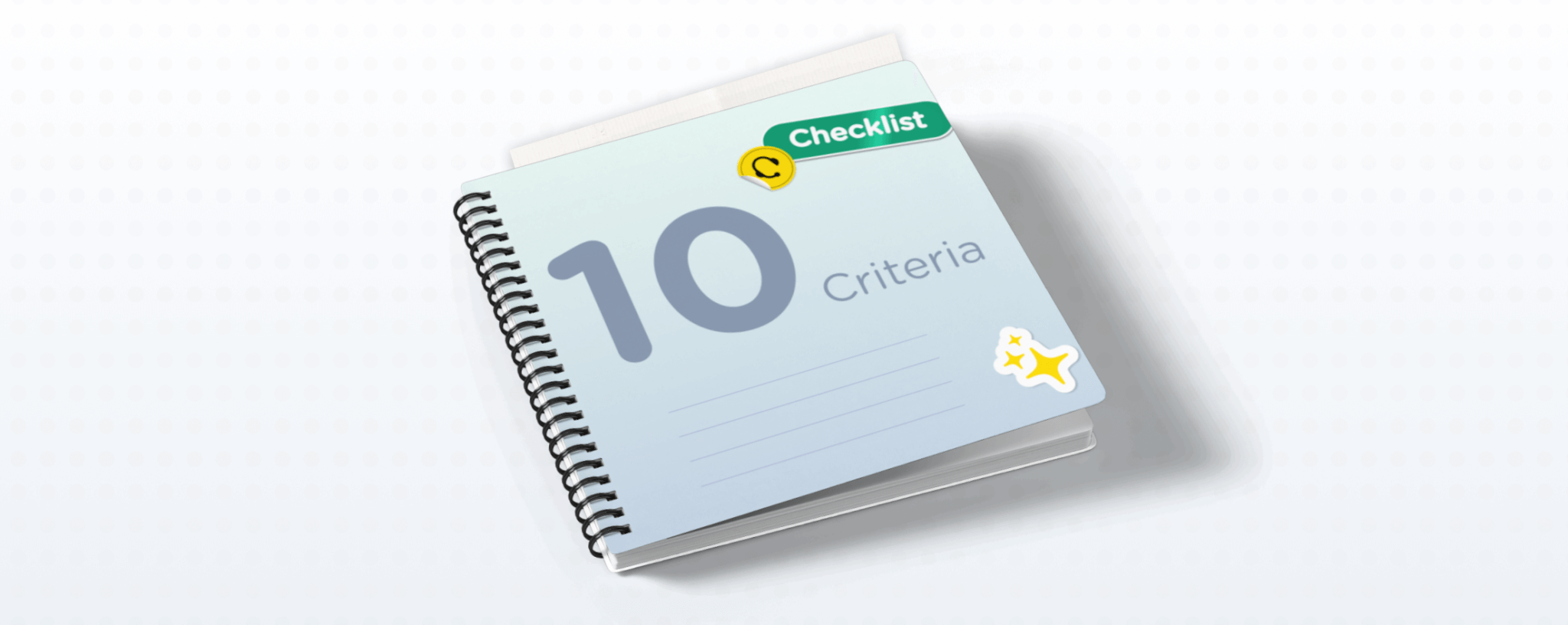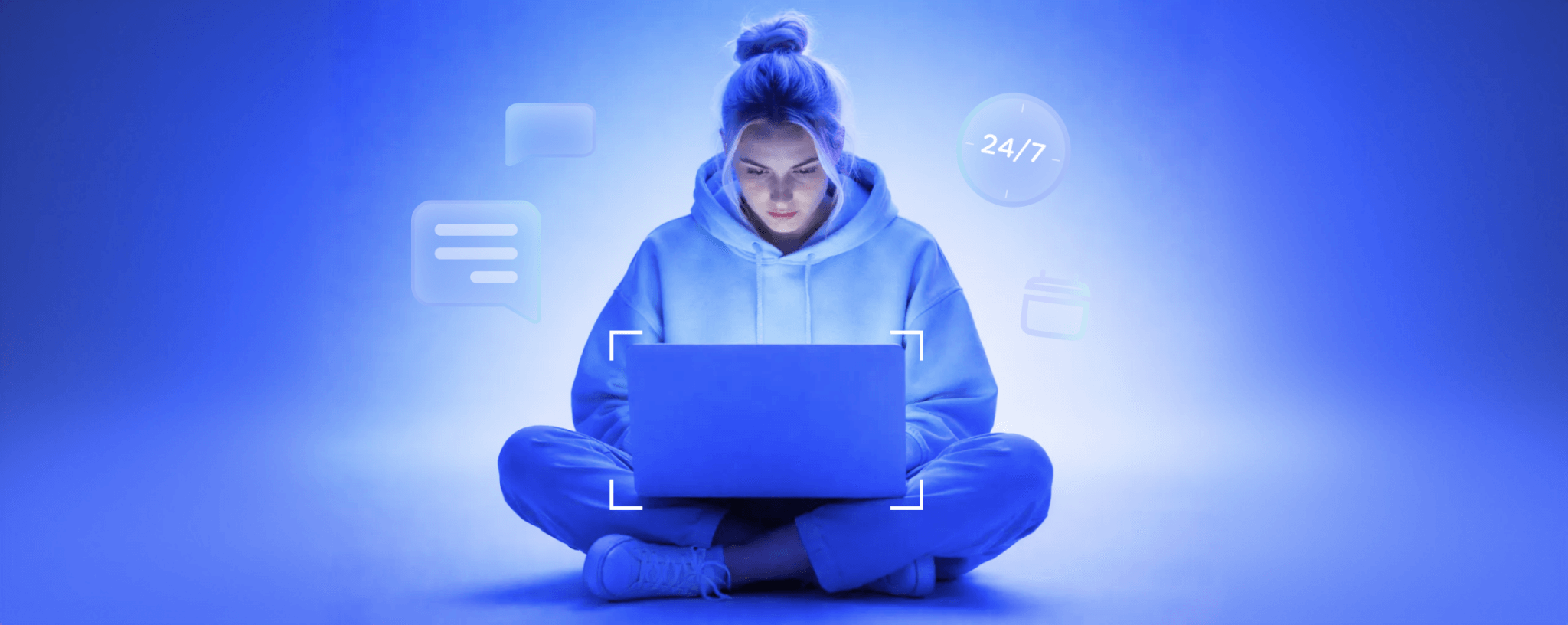According to amplifAI, US companies lose up to $75 billion annually as a result of poor customer service.
This underscores the critical role that customer Service Level Agreements play in maintaining operational efficiency and customer satisfaction. They serve as a measurable framework that holds teams accountable and ensures consistency in service delivery.
What does SLA stand for in customer service? Basically, it’s the defined service expectations between the customer and the support team, the ground rules and protocols for case resolution and quality standards.
A customer service SLA provides service guarantees to the customer and proves to be crucial to maintaining high satisfaction levels and building trust. Now let’s move on to the types of SLAs.
Types of SLA in Customer Service
There are three different types of SLAs, each designed to meet specific service expectations:
Customer-Based SLA
This type of SLA is tailored to a specific client, outlining all the services they receive and the agreed performance standards for each. It’s a one-to-one agreement that reflects the customer’s unique needs and priorities.
This type of SLA is ideal for businesses offering personalized service packages, allowing for clear expectations on both sides — such as dedicated support hours, custom response times, or reporting requirements.
An example of these types of commitments might be a 30-minute resolution time for critical issues in a hospital, with a clear process to escalate urgent cases to senior support agents.

Service-Based SLA
Unlike a customer-based SLA, a service-based SLA applies the same service standards to all customers, ensuring consistent and compliant delivery aligned with high performance expectations. Key performance indicators (KPIs) help streamline service desk operations and maintain service quality.
For example, a cloud provider may guarantee 99.9% uptime and a 2-hour response time for all users, regardless of their individual contracts.
Multilevel SLA
A multilevel SLA introduces a tiered approach to service management, breaking down a standard SLA into multiple layers to better align with specific customer groups or service components. This structure allows for greater customization and control over service delivery.
Each tier defines its own set of performance metrics and service parameters, tailored to the unique needs of different customer segments.
By differentiating service levels based on factors like subscription plans, usage patterns, or business priorities, multilevel SLAs help companies deliver more competitive and personalized support.
For example, a SaaS company may offer basic support with longer response times to all users, while premium subscribers receive priority assistance and faster resolutions.
The diagram below summarizes the three types of SLAs.

Key Customer Service SLA Metrics
One of the key steps in service level management is defining and documenting the key SLA metrics. These often align with the customer satisfaction KPIs used to measure service quality. Specific metrics may vary by industry, but all are essential for maintaining high levels of customer service.
Resolution Time
Resolution time refers to the total time it takes for an agent to resolve a ticket once it’s opened. It’s influenced by other metrics like:
- First Response Time – how long it takes to respond to a request.
- One-Touch Resolution Rate – the percentage of tickets resolved by the first responding agent
- Hold Time – the time customers wait on the line for an active agent
SLA response time is a key metric tracked across both B2C and B2B industries.
This metric will state the average amount of time customers can expect to wait after an issue is flagged. Staying compliant with this timeframe helps maintain strong service performance and customer trust.
Customer Satisfaction (CSAT)
CSAT stands for Customer Satisfaction Score and measures how satisfied customers are with a specific interaction or overall service experience. Typically collected through post-interaction surveys with questions like “How satisfied were you with the support you received?”, CSAT is expressed as a percentage — calculated by dividing the number of satisfied responses by the total number of responses.
It is also one of the metrics to measure customer engagement and provide an overall score for the entire customer experience. According to Nextiva, in the past, acceptable CSAT benchmarks used to hover around 75%, but now the expected average is a score above 85%.
Average Handling Time (AHT)
AHT refers to the average amount of time an agent spends handling a customer interaction from start to finish. It typically includes:
- Talk/chat time – The time spent directly communicating with the customer
- Hold time – Time the customer spends on hold during the interaction
- After-call work (ACW) – Time spent by the agent wrapping up the case (e.g., writing notes, updating systems)
Best Practices for Effective SLAs
Here are some help desk SLA best practices you might want to consider when setting expectations and defining performance standards.
Align SLA Targets With Capacity
It’s not enough to have clear objectives in place; these objectives also need to be achievable, otherwise you are setting yourself up for failure before the contract is even signed. Unrealistic customer support SLAs will lead to mistrust and should be thoroughly tested before being formalized in ink.
Make SLAs Customer-Focused
Building an SLA for customer service isn’t just about meeting internal KPIs — it must also prioritize the customer experience. To do that, focus on satisfaction metrics like CSAT and monitor customer churn, which reflects how well you’re retaining customers. Satisfied customers are far less likely to churn, making this a key indicator of long-term success.
Luis Hernandez, the VP of Customer Success at Geckoboard, a company that specializes in real-time KPI dashboards, says that “timeliness and speed have a direct correlation with satisfaction. A first response perceived as fast can set you on the right track for a positive first impression.”
SLA Transparency
Transparency builds trust and helps shape a positive customer experience. One of the best ways to achieve this is by clearly outlining your SLA expectations — on your support portal, in FAQs, and within contract documentation.
The image below highlights three core practices that define a strong SLA agreement.

However, you do not need to do all of this yourself. SupportYourApp offers help desk outsourcing services featuring professional, hand-picked teams of experienced consultants for both long-term and short-term contracts, flexible service packages, regular tracking of KPIs, and QA reports giving you access to the support you have been looking for.

Examples of SLA for Customer Service
SLAs can be integrated into various aspects of customer support operations. Let’s take a closer look at some examples of how SLA call center metrics can be applied in real time:
1. Average Response and Resolution Times
Your SLA should clearly state how long customers can expect to wait for a response after submitting a support ticket. This helps reduce anxiety and sets realistic expectations.
It’s also important to include estimated resolution times and note any variations during peak periods to maintain transparency and prevent frustration.
2. Business Hours and Support Availability
Make sure your SLA and website clearly outline when support is available. This avoids confusion and ensures customers don’t expect responses outside working hours.
Additionally, offering self-service options for simpler queries can empower users to find solutions quickly, especially outside business hours. These can include a FAQ section, an AI chatbot, or a knowledge base that guides customers through common issues without needing live support.
3. Escalation Procedures
Define the escalation path within the SLA based on issue severity. This ensures that tickets are routed to the appropriate support tier from the outset, minimizing unnecessary handoffs.
Clear escalation rules improve first contact resolution rates and reduce customer frustration.
Summary
SLAs in customer service define the service expectations between the support team and the customer or client, setting clear protocols for case resolution, response times, and quality standards. These agreements act as a service guarantee and help build long-term trust.
Key SLA metrics typically include resolution time, CSAT (Customer Satisfaction Score), and average handling time (AHT). To make SLAs effective, best practices include setting measurable goals, aligning targets with customer needs, adopting a customer-first mindset, and ensuring full transparency.
A well-crafted SLA lays the foundation for consistently high-quality support—and positions your company to exceed customer expectations.
FAQs
What Is SLA in Customer Service?
SLA defines the expected level of support between a company and its customer, setting clear standards for response times, case resolution, and overall service quality. The SLA meaning in customer service lies in its role as a mutual commitment to accountability and consistent performance.
What Are the Three Types of SLAs?
SLAs can be grouped into three categories:
- Customer-based: tailored to the specific needs of an individual client or customer group.
- Service-based: applies a uniform set of service standards to all customers using the same service.
- Multilevel: offers tiered service levels across different pricing plans or user groups, addressing varying needs and expectations.
What Is a Good SLA for a Call Center?
A good SLA for a call center sets clear expectations for response times, resolution speed, and customer satisfaction — while remaining realistic based on the support team’s capacity and the needs of the customer.
SLA vs KPI: What’s the Difference?
An SLA is a formal agreement between the business and the client that defines service expectations and responsibilities. KPIs, on the other hand, are internal performance metrics used to measure how well the support team is meeting those SLA commitments.
❤︎ Like it? — Share: Share on LinkedIn or Share on Facebook

An indispensable member of the SupportYourApp team, Ilya initially majored in French philology before discovering his passion for the customer support industry. As a Service Delivery / Account Management Director, he helps support teams deliver exceptional services to clients’ customers. Ilya has developed a unique management approach that combines coaching with transformation management, allowing him to establish clear direction while giving team members the space for personal accountability, skills development, and creativity.
Posted on


 LinkedIn
LinkedIn

